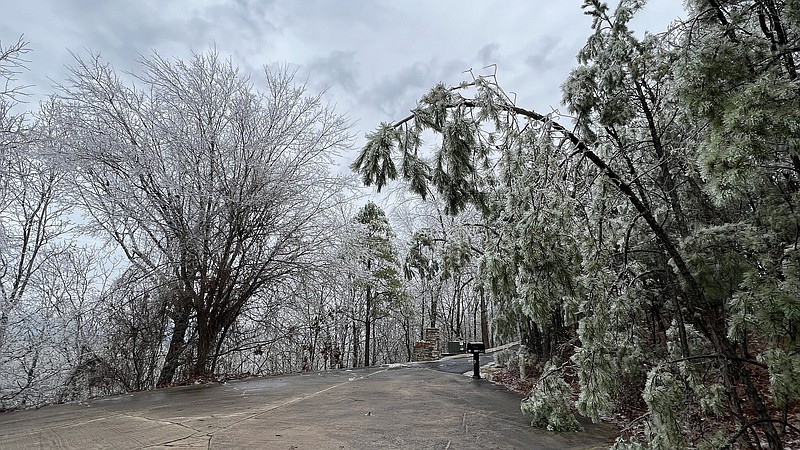Even though the ice storm has passed, some of its dangers haven't.
Some parts of Arkansas received three rounds of wintry weather recently. The National Weather Service at North vLittle Rock said parts of north Arkansas received 1 to 2 inches of sleet. Across the central part of the state, from Oklahoma to the Mississippi River, freezing rain dropped more than a quarter inch of ice.
Wintry precipitation plagued the southern half of the state Feb. 1-2. Some 72,000 people across south Arkansas were without power on Feb. 2.
The ice and sleet weighed heavily on trees, arching pines and in some cases, breaking trees. Adding to the danger is saturated soil from melting ice, making it easier for top-heavy trees to fall.
SOUNDS LIKE AN ARTILLERY RANGE
Bear State Tales podcaster Matt Manos of Star City described the "steady rumble of tree and large limbs falling south side of Lincoln County" in his @PJMountexplorer Twitter account. With an image of an ice-covered tree falling across a road, he said "'we have moved to the 'sounds like an artillery range' portion of the ice storm in Lincoln County." His video snippet of a large falling limb makes the point at shorturl.at/gjM29.
WHAT NEXT?
As the weather clears, homeowners and landowners will be out assessing their properties for potential damage.
First, "stay away from power lines," said Vic Ford, a forester who heads extension agriculture and natural resources for the University of Arkansas System Division of Agriculture. "Report them to the local utility and let the professionals take care of them."
The next step is to "do a hazard assessment for damaged trees," said Kyle Cunningham, extension forester for the University of Arkansas System Division of Agriculture. "What targets are in the path if a tree or limb falls? Injured trees that pose high threats to humans or structures should be dealt with first.
"If the threat to nearby targets is not as significant, removal of those stems can be completed at a more convenient time," Cunningham said. "Tree removal should include professional assistance, preferably from a certified arborist."
Cunningham said property owners also need to "evaluate how severe the injury to the tree is."
"Should I remove the injured portion of the tree or the entire tree? The answer to this question is best answered by an arborist," he said. "Some rules-of-thumb are that if you can remove less than one-quarter of the tree crown, limb removal will likely not significantly impact tree health. If you must remove greater than one-quarter of the tree crown, risk to tree health, vigor and structural soundness may become questionable."
WHAT ABOUT THE BENT TREES?
"Small trees may appear permanently bent but research has shown that small trees have an amazing ability to straighten in a few months," Ford said.
Ford said broken branches should be evaluated when it is safe to examine them.
"Cutting the broken branches if still attached and trimming up the stub may ensure tree health for the future," he said.
"The time to remove branches that may cause damage is not during the storm, but way before any storm hits," Ford said. "Examine the large branches and remove them if they can damage property if they fall. Dead branches should always be removed. A licensed arborist is the best bet to determine proper care of large trees."
The Cooperative Extension Service has a page at https://www.uaex.uada.edu/environment-nature/disaster/ dedicated to disaster recovery, including dealing with trees.
To learn about extension programs in Arkansas, contact a local Cooperative Extension Service agent or visit www.uaex.uada.edu. Follow them on Twitter and Instagram at @AR_Extension.
Mary Hightower is with the University of Arkansas System Division of Agriculture.
